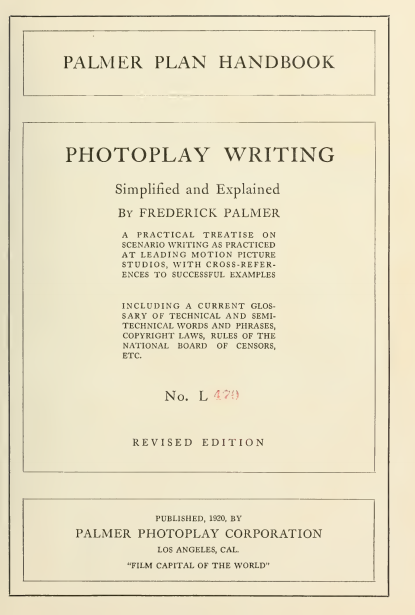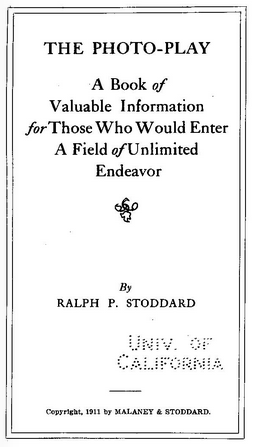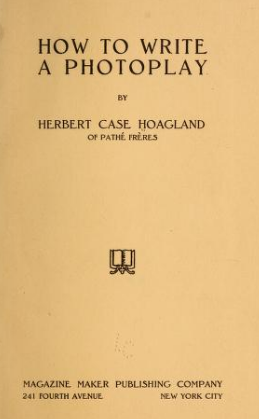An Overview of Screenwriting Manuals since 1913 1911!
As with the previous brief history of Structural and Anthropological Narratology research (see: StoryAlity #27, Narratology Since Plato), this research, (and the Ev Cult doctoral research study which produced it), is part of a tradition (of just over 100 years) of analyzing movies/movie screenplays/stories, to find common elements that screen storytellers can use as “practical writing aids/tools” while writing in the commerce-driven environment of the film industry.
As my 02016 Evolutionary Culturology/ StoryAlity Theory PhD dissertation (free online) explains in much more detail –
A very brief history of Screenplay/Movie Story “How To” instructional manuals is as follows:
- In 1911 Ralph P Stoddard published The Photo-Play: A Book of Valuable Information for Those Who Would Enter A Field of Unlimited Endeavour. I have looked very hard, and am pretty sure that this is the first-ever screenwriting “How-To” Manual…(?) (You can read it free online – just exactly like my PhD, only different.)
- In 1912 Herbert Case Hoagland published How To Write A Photoplay.
- In 1913 William Lewis Gordon published How to Write Moving Picture Plays, in which he outlines how to write silent films, including the wise advice: “REMEMBER THAT A PLAY EASILY PRODUCED IS FAR MORE LIABLE TO BE ACCEPTED THAN ONE REQUIRING THOUSANDS OF DOLLARS TO STAGE.” (Gordon 1913: 21)
- Also in 1913 Epes Winthrop Sargent published Technique of the Photoplay. New York: The Moving Picture World and Chalmers Publishing Company
- Also in 1913 – Eustace Hall Ball, The Art of the Photoplay, New York: Veritas Publishing Co.
- Again in 1913 (a big year for Screenplay Manuals) – J Berg Esenwein and Athur Leeds, Writing The Photoplay. Springfield, Mass.: The Home Correspondence School
- In 1914 A. W. Thomas published How to Write a Photoplay including advice on Story, the theme and its material, the division into scenes, the action, unity, sequence, suspense, unexpectedness, crisis and climax.

(Palmer 1920)
- 1920 – Frederick Palmer released Palmer Plan Handbook: Photoplay Writing simplified and explained. Los Angeles: Palmer Photoplay Corp.
- 1920 – John Emerson and Anita Loos How To Write Photoplays. New York: McCann
- Also 1920 – Frances Taylor Patterson Cinema Craftsmanship. A Book for Photoplaywrights. New York: Harcourt, Brace and Howe
- 1922 – Frederick Palmer Photoplay Plot Encyclopedia. An Analysis of the Use in Photoplays of the Thirty-Six Dramatic Situations and Their Subdivisions. Hollywood. Palmer Photoplay Corporation. (Notably – this refers to Georges Polti’s work The Thirty-Six Dramatic Situations [1916], but Polti claims to be continuing the work of playwright Count Carlo Gozzi, who lived 1720-1806.) An interesting case of cultural evolution! You can trace these concepts back and back, in a phylogenetic tree.
- 1924 – Frederick Palmer Technique of the Photoplay. Hollywood: Palmer Institute of Authorship
- 1928 – Frances Taylor Patterson Scenario and Screen. New York: Harcourt Brace and Company
- 1929 – Frances Taylor Patterson Motion Picture Continuities. New York: Columbia University Press.
- 1936 – Tamar Lane The New Technique of Screen Writing. A Practical Guide to the Writing and Marketing of Photoplays. New York, London: McGraw-Hill
- 1936 – John Howard Lawson Theory and Technique of Playwriting and Screenwriting. New York: G P Putnam’s Sons
- 1937 – Norman Lee Money For Film Stories. London: Sir Isaac Pitman & Sons
- Also 1937 – Frances Marion How To Write and Sell Film Stories. With a Complete Shooting Script for Marco Polo by Robert E Sherwood. New York: Covici Friede Publishers.
- In 1946 – Lajos Egri published The Art of Dramatic Writing. Though it’s for plays (and theater is not: cinema!), a lot of the dramatic guidelines in it are actually very useful for movie screenwriters.
And – `The Modern Era’ of Screenplay Manuals: (notably – cinema changed after `The Paramount Antitrust Case of 1948‘.)
- In 1979 Syd Field published Screenplay, in which he outlined the 3-act structure that he claims feature film screenplays follow, including a misconception of “Aristotelian 3-Act structure”. Notably however the films studied in Screenplay are selective and illustrative, the story system is not the result of an empirical or scientific study. Screenplay has sold over 1 million copies and has dominated the screenwriting convention.
- In 1983 William Goldman published Adventures in the Screen Trade: A Personal View of Hollywood and Screenwriting. Though not a screenwriting manual, it contains advice on story structure and dramatic writing. Originally a novelist and Broadway playwright, Goldman is regarded as one of the most successful Hollywood screenwriters, in terms of both art and commerce. Notably this text contains the quote “Nobody knows anything”. However Goldman was working in a pre-paradigm era, when consilient, empirical and scientific research of narrative and film success (such as, perhaps, this doctoral research study) did not yet exist.
- In 1984 Syd Field published The Screenwriter’s Workbook.
- In 1987 Linda Seger (a student of Field’s) published Making a Good Script Great. This story system is essentially similar to (an extension and complication of) Field’s.
- In 1989, Syd Field published Selling a Screenplay.
- In 1989 Michael Hauge published Writing Screenplays That Sell. (Notably however the screenplays studied in the book were not primarily `spec’ screenplays.)
- In 1990, T L Katahn published Reading For A Living: How to be a Professional Story Analyst for Film and Television, which explains how professional screen readers (aka screen industry “gatekeepers”) analyze scripts. There is also now a body of literature on Screen Reading, and for a sample of it see: Chapter 4.3.5 A review of Movie Screenplay Assessment Literature (on pp. 107-9 of my PhD dissertation.) Namely, if you are writing a script, you should also understand how readers will assess it. (In the scientific study of creativity, this is called “Internalizing the Rules of the Domain, that you are trying to be creative in,” See also: Creative Practice Theory.)
- In 1992 Christopher Vogler published The Writer’s Journey, in which he applies the Joseph Campbell monomyth (aka hero’s journey) structure to various popular movies. (Chris Vogler was one of my many screenwriting mentors at Film School (AFTRS) in 1995-6 – and, we both have articles on the monomyth in the March 2018 issue of The Journal of Genius and Eminence.)
- In 1994 Melanie Anne Phillips and Chris Huntley released Dramatica screenwriting and story software.
- Also in 1994 David Trottier published The Screenwriter’s Bible.
- Also in 1994 Syd Field published Four Screenplays in which he analyzed (guess what?) four screenplays: Thelma & Louise, Terminator 2, The Silence of the Lambs, and Dances With Wolves. (Side Note: The Silence of the Lambs is the only Horror Genre movie to win the Oscar for Best Picture (in the year: 1991).
- In 1997 Robert McKee published Story, in which he outlines his “dramatic principles” and presents his “10 commandments”. However like Aristotle, McKee selectively chooses his examples to illustrate his points (or `principles’), regardless of whether the films examined were `successful’ or not. Yet in 2014, this remains a highly-influential screenwriting manual, possibly largely due to its strong rhetoric.
- In 1998, Syd Field published The Screenwriter’s Problem Solver.
- In 2001 Karl Iglesias published The 101 Habits of Highly Successful Screenwriters. See also this post on “The 10-year rule in creativity” (Hayes 1989) for some brief excerpts from it!
- In 2001, Syd Field published Going To The Movies.
- In 2002 Richard Stefanik published The Megahit Movies, a study of the common story structure elements in films that had U.S. domestic box-office grosses of $250 million or more. This is one of the few screenwriting manuals with a clearly-defined data set. However – given that only experienced screenwriters write films with the sorts of budgets involved in these films, this book is arguably not useful to most screenwriters; such high budget films are unlikely to be financed.
- In 2005 Blake Snyder published Save The Cat! in which he presents 12 plot steps in selected film stories. Snyder’s genre classifications are a worthy contribution to screenwriting literature.
- Also in 2005, Victoria Lynn Schmidt published Story Structure Architect, which extrapolated Polti’s 36 dramatic situations into 55, with a feminine perspective.
- In 2007 John Truby published The Anatomy of Story in which he outlined 22 steps in various film stories.
- Also in 2007, Dancyger and Rush published Alternative Scriptwriting: Writing Beyond The Rules. I do like their point about Irony (using Ironic Tone) in this book.
- In 2008 William M Akers published Your Screenplay Sucks! 100 Ways To Make It Great.
- Also in 2008, Syd Field published The Definitive Guide to Screenwriting.
- In 2011 Todd Klick published Something Startling Happens, a minute-by-minute analysis of story events in certain well-known films.
- In 2013 Peter Bloore published the book The Screenplay Business: Managing Creativity in the Film Industry. The book is a result of a PhD by prior publication (Bloore, 2014). As reviewed in the Journal of Screenwriting (Velikovsky, 2014), Bloore’s (2013) book provides the first framing of the screenplay development process in terms of the extant scientific research on creativity as both a business and an art form.

My PhD – on Movie Creativity and The Top 20 RoI Movies
- In 2016 I published my PhD on Movie Creativity & Cultural Evolution, including an examination of the creative person, potential, process, product (the screenplay and movie), place, and persuasion. It examines “the screenwriting convention” (the orthodox guidelines [or “doxa”] on how screenwriting is taught, and then compares [in fact: tests] those guidelines against the Top – and bottom – 20 Return on Investment movies to see just how well many of the guidelines from the above books correlate with success). Read the PhD! – It’s online, and it’s: free!
- I also published a StoryAlity Screenwriting Manual (2013), including guidelines (Do’s & Don’ts) derived from the study of the top and bottom 20 RoI movies.
- UPDATE: In April 2018, I see that Syd Field (although, sadly passed now – and what an amazing contribution to the literature!) is publishing The Essential Screenplay (3-Book Bundle): Screenplay, Screenwriter’s Workbook, and Screenwriter’s Problem Solver (3-book bundle on Kindle. …A Kindle-bundle!)
In 1995, 2003 and 2011 I also published an Academic Summary Review of about 100 of the most popular of the above: (I summarized each book, into a page). It is free online here:
(FREE @ Lulu.com)
And (as mentioned above) during my PhD, I also published this one: (but frankly it was a bit rushed…)
StoryAlity #67 – The STORYALITY™ Screenwriting Manual (2013): out now on Kindle
So; this listicle above is, by no means, a comprehensive list of all Screenwriting Instructional Manuals.
(There are over 2,500 on Amazon.com)…!
(So which are the good ones? For one answer, see my PhD…!)
Additional information on the history of Screenwriting Manuals can also be found in Edward Azlant’s great 1980 PhD dissertation, The Theory, History, and Practice of Screenwriting, 1897-1920, in Assoc Prof Steven Maras’s excellent book Screenwriting: History, Theory, and Practice (2009), and in Marc Norman’s, What Happens Next: A History of American Screenwriting. New York: Harmony Books (2007).
However – in terms of the most popular, well-recognized and accepted (and academically-cited) texts, these works listed above are some of the “key milestones” in screenwriting manuals – as recognized within the film industry, and the academy (I mean academia, not: AMPAS, …but maybe even there, too).
And see also: The Screenwriting Research Network! Which I am also in.
And – hey, you probably should be, too?
(It’s free! …Free’s always good? Well; usually?)
Note however that – almost all of these `popular’ Screenwriting Manuals are not consilient, and do not use an empirical sample of successful films/movies, for their study sample data-set of films/screenplays…
Their findings may therefore (possibly) be dubious – and in general, are not supported by empirical, nor scientific evidence…
Just sayin’.
Also – a recent (2015) addition to the literature:
I have some articles in “Miller’s Compendium of Timeless Tools for the Modern Writer” by Greg Miller (Author, Editor, 2015)
Amazing book, and not just because I’m in it. Nice work Greg.
(And, the illustrations are great, too.)
Also in 2016, I published this book-chapter (it was also an Appendix to my PhD):
StoryAlity #132 – The holon/parton structure of the Meme, the unit of culture (and narreme, or unit of story) (2016)
More recently, it is also in The Encyclopedia of Creativity (2020).
And, the above scientific models of cultural evolution (Velikovsky 2016-2020) are expanded in a forthcoming book (November 2021), titled: P3 of EC.
So, enjoy!
(…If, you like that kind of thing?)
THE END.
Thoughts? Comments? Systems-Feedback-Loops?
——————————————–

& High-RoI (benefit/cost ratio) Story/Screenplay/Movie & Transmedia Researcher
The above is (mostly) an adapted excerpt, from my (02016) Ev Cult doctoral thesis: “Communication, Creativity and Consilience in Cinema”.
It is presented here for the benefit of fellow screenwriting, filmmaking and creativity researchers.
For more information (if you like that kind of thing), see https://aftrs.academia.edu/JTVelikovsky
They tell me: JT Velikovsky is also a produced feature film screenwriter & million-selling transmedia writer-director-producer. And has been a professional Story Analyst (screen reader) for major film studios, film funding organizations, and for the national writer’s guild.
For way too much more info, see: http://on-writering.blogspot.com/
————————————
NOTES
My sincere Thanks go to screenwriter and screenwriting teacher Raija Talvio MA, for assisting in this research, and especially for pointing me towards Claus Tieber’s excellent book ‘Schreiben für Hollywood’ (‘Writing for Hollywood’) Münster: Lit Verlag, (2008).
As Raija also notes: “In the book Tieber writes about the time of the ‘scenario fever’ around 1912 – that there was a boom of magazines advising about scenario writing: Picture World, Monography, Motion Picture Story, Photoplay, Photo Playwright, Author, Motion Picture News, Script, Photoplay Scenario and Photoplaywright. The source for this is Richard Koszarski’s book ‘An Evening’s Entertainment: The Age of the Silent Feature Picture: 1915 – 1928‘. Also – a very brief presentation about the genealogy of screenwriting theory from a Scandinavian – Central European point of view of is available here: http://zakka.dk/euroscreenwriters/articles/history_of_dramaturgy_539.htm. At archive org you will also find the drama theory book of William Archer Play-Making: A Manual of Craftsmanship (1912), which has been published in many printings and seems to be the direct source of many modern screenwriting manuals. http://archive.org/details/playmakingamanu00archgoog“.
Raija also notes: “A mid-century influence in Central Europe was Vsevolod Pudovkin, a contemporary of Eisenstein, Kuleshov and Vertov in the Soviet Union. His book about filmmaking was translated into German in 1928. The Foreword of the translation was written by Thea von Harbou, the screenwriter of Metropolis and wife of Fritz Lang. Pudovkin was not translated into English before 1950s, but that English translation is also available at archive org.: ‘Film Technique; and Film Acting: the Cinema Writings of V.I. Pudovkin’ (1954) http://archive.org/details/filmtechniqueact00pudo Daniel Gritten’s thesis ‘The Profession and Practice of Screenwriting in British Cinema: The 1920s and 1930s’ is also downloadable at the British Library website http://ethos.bl.uk/Home.do”
Notably, Raija has written an article about the public debate about screenwriting in 1930’s Finland: ‘First of all, the screenplay problem has to be solved’. It was published in the Journal of Screenwriting in Issue 2/2010.
Notably, the Journal of Screenwriting is the only academic, peer-reviewed journal devoted to Screenwriting. It was first published in 2010. I commend it to you.
See also, the great site: http://roteirodecinema.com.br/wp/os-manuais-de-roteiro-do-cinema-mudo/ (which is where I found out about the – earlier – 1911 manuals!)
REFERENCES
Include, but are not limited to:
Gordon, William Lewis (1913), How To Write Moving Picture Plays (Cincinatti: Atlas Publishing Company). http://archive.org/stream/howtowritemovin00gordgoog#page/n6/mode/2up
See also: Recent Publications (02023)

Elements of Ev Cult (2nd Ed, 02023)











Pingback: StoryAlity #68 – StoryAlity Theory 3MT @ Interventions and Intersections 2013 | StoryAlity
Pingback: StoryAlity #69 – StoryAlity Theory 20-min Paper @ I-and-I Conference 2013 | StoryAlity
Pingback: Os Manuais de Roteiro do Cinema Mudo | Site Title
very resourceful for film scholars and practioners
Pingback: StoryAlity #126 – Miller’s Compendium of Timeless Tools for the Modern Writer | StoryAlity
Pingback: StoryAlity #145 – Five Views of the Mono-Myth | StoryAlity
Pingback: StoryAlity#150 – Key Findings from the StoryAlity PhD on High-RoI Movies | StoryAlity
Pingback: StoryAlity #118 – The 1000 Project – The 1000 `Rules’ of Screenwriting (Velikovsky) | StoryAlity
Pingback: StoryAlity #27 – Narratology since Plato – a Brief Lit Review | StoryAlity
Pingback: StoryAlity #153 – Film Production Courses vs. (so-called) `Film Theory’ | StoryAlity
Do you still publish screenwriting manuals with new angles to writing screenplays?
Hi Janet; yeah! I do… But the one I’m currently writing is taking a long time…
Pingback: StoryAlity #173 – Ev Cult – and Information, Communication, and Systems Science | StoryAlity
Pingback: StoryAlity #60 – On Character and Story – in the Top 20 ROI Films | StoryAlity